Jag Mohan Singh
3D Face Morphing Attack Generation using Non-Rigid Registration
Apr 24, 2024Abstract:Face Recognition Systems (FRS) are widely used in commercial environments, such as e-commerce and e-banking, owing to their high accuracy in real-world conditions. However, these systems are vulnerable to facial morphing attacks, which are generated by blending face color images of different subjects. This paper presents a new method for generating 3D face morphs from two bona fide point clouds. The proposed method first selects bona fide point clouds with neutral expressions. The two input point clouds were then registered using a Bayesian Coherent Point Drift (BCPD) without optimization, and the geometry and color of the registered point clouds were averaged to generate a face morphing point cloud. The proposed method generates 388 face-morphing point clouds from 200 bona fide subjects. The effectiveness of the method was demonstrated through extensive vulnerability experiments, achieving a Generalized Morphing Attack Potential (G-MAP) of 97.93%, which is superior to the existing state-of-the-art (SOTA) with a G-MAP of 81.61%.
VoxAtnNet: A 3D Point Clouds Convolutional Neural Network for Generalizable Face Presentation Attack Detection
Apr 19, 2024Abstract:Facial biometrics are an essential components of smartphones to ensure reliable and trustworthy authentication. However, face biometric systems are vulnerable to Presentation Attacks (PAs), and the availability of more sophisticated presentation attack instruments such as 3D silicone face masks will allow attackers to deceive face recognition systems easily. In this work, we propose a novel Presentation Attack Detection (PAD) algorithm based on 3D point clouds captured using the frontal camera of a smartphone to detect presentation attacks. The proposed PAD algorithm, VoxAtnNet, processes 3D point clouds to obtain voxelization to preserve the spatial structure. Then, the voxelized 3D samples were trained using the novel convolutional attention network to detect PAs on the smartphone. Extensive experiments were carried out on the newly constructed 3D face point cloud dataset comprising bona fide and two different 3D PAIs (3D silicone face mask and wrap photo mask), resulting in 3480 samples. The performance of the proposed method was compared with existing methods to benchmark the detection performance using three different evaluation protocols. The experimental results demonstrate the improved performance of the proposed method in detecting both known and unknown face presentation attacks.
Sound-Print: Generalised Face Presentation Attack Detection using Deep Representation of Sound Echoes
Sep 24, 2023Abstract:Facial biometrics are widely deployed in smartphone-based applications because of their usability and increased verification accuracy in unconstrained scenarios. The evolving applications of smartphone-based facial recognition have also increased Presentation Attacks (PAs), where an attacker can present a Presentation Attack Instrument (PAI) to maliciously gain access to the application. Because the materials used to generate PAI are not deterministic, the detection of unknown presentation attacks is challenging. In this paper, we present an acoustic echo-based face Presentation Attack Detection (PAD) on a smartphone in which the PAs are detected based on the reflection profiles of the transmitted signal. We propose a novel transmission signal based on the wide pulse that allows us to model the background noise before transmitting the signal and increase the Signal-to-Noise Ratio (SNR). The received signal reflections were processed to remove background noise and accurately represent reflection characteristics. The reflection profiles of the bona fide and PAs are different owing to the different reflection characteristics of the human skin and artefact materials. Extensive experiments are presented using the newly collected Acoustic Sound Echo Dataset (ASED) with 4807 samples captured from bona fide and four different types of PAIs, including print (two types), display, and silicone face-mask attacks. The obtained results indicate the robustness of the proposed method for detecting unknown face presentation attacks.
Deep Composite Face Image Attacks: Generation, Vulnerability and Detection
Nov 20, 2022Abstract:Face manipulation attacks have drawn the attention of biometric researchers because of their vulnerability to Face Recognition Systems (FRS). This paper proposes a novel scheme to generate Composite Face Image Attacks (CFIA) based on the Generative Adversarial Networks (GANs). Given the face images from contributory data subjects, the proposed CFIA method will independently generate the segmented facial attributes, then blend them using transparent masks to generate the CFIA samples. { The primary motivation for CFIA is to utilize deep learning to generate facial attribute-based composite attacks, which has been explored relatively less in the current literature.} We generate $14$ different combinations of facial attributes resulting in $14$ unique CFIA samples for each pair of contributory data subjects. Extensive experiments are carried out on our newly generated CFIA dataset consisting of 1000 unique identities with 2000 bona fide samples and 14000 CFIA samples, thus resulting in an overall 16000 face image samples. We perform a sequence of experiments to benchmark the vulnerability of CFIA to automatic FRS (based on both deep-learning and commercial-off-the-shelf (COTS). We introduced a new metric named Generalized Morphing Attack Potential (GMAP) to benchmark the vulnerability effectively. Additional experiments are performed to compute the perceptual quality of the generated CFIA samples. Finally, the CFIA detection performance is presented using three different Face Morphing Attack Detection (MAD) algorithms. The proposed CFIA method indicates good perceptual quality based on the obtained results. Further, { FRS is vulnerable to CFIA} (much higher than SOTA), making it difficult to detect by human observers and automatic detection algorithms. Lastly, we performed experiments to detect the CFIA samples using three different detection techniques automatically.
Reliable Face Morphing Attack Detection in On-The-Fly Border Control Scenario with Variation in Image Resolution and Capture Distance
Sep 30, 2022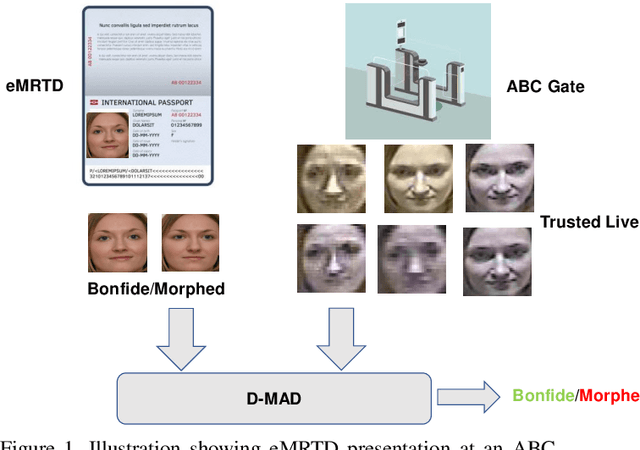

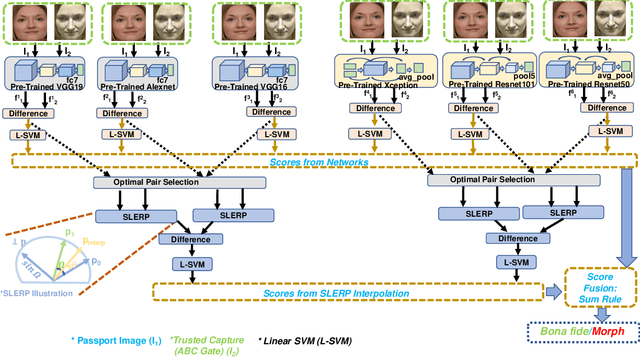

Abstract:Face Recognition Systems (FRS) are vulnerable to various attacks performed directly and indirectly. Among these attacks, face morphing attacks are highly potential in deceiving automatic FRS and human observers and indicate a severe security threat, especially in the border control scenario. This work presents a face morphing attack detection, especially in the On-The-Fly (OTF) Automatic Border Control (ABC) scenario. We present a novel Differential-MAD (D-MAD) algorithm based on the spherical interpolation and hierarchical fusion of deep features computed from six different pre-trained deep Convolutional Neural Networks (CNNs). Extensive experiments are carried out on the newly generated face morphing dataset (SCFace-Morph) based on the publicly available SCFace dataset by considering the real-life scenario of Automatic Border Control (ABC) gates. Experimental protocols are designed to benchmark the proposed and state-of-the-art (SOTA) D-MAD techniques for different camera resolutions and capture distances. Obtained results have indicated the superior performance of the proposed D-MAD method compared to the existing methods.
3D Face Morphing Attacks: Generation, Vulnerability and Detection
Jan 10, 2022



Abstract:Face Recognition systems (FRS) have been found vulnerable to morphing attacks, where the morphed face image is generated by blending the face images from contributory data subjects. This work presents a novel direction towards generating face morphing attacks in 3D. To this extent, we have introduced a novel approach based on blending the 3D face point clouds corresponding to the contributory data subjects. The proposed method will generate the 3D face morphing by projecting the input 3D face point clouds to depth-maps \& 2D color images followed by the image blending and wrapping operations performed independently on the color images and depth maps. We then back-project the 2D morphing color-map and the depth-map to the point cloud using the canonical (fixed) view. Given that the generated 3D face morphing models will result in the holes due to a single canonical view, we have proposed a new algorithm for hole filling that will result in a high-quality 3D face morphing model. Extensive experiments are carried out on the newly generated 3D face dataset comprised of 675 3D scans corresponding to 41 unique data subjects. Experiments are performed to benchmark the vulnerability of automatic 2D and 3D FRS and human observer analysis. We also present the quantitative assessment of the quality of the generated 3D face morphing models using eight different quality metrics. Finally, we have proposed three different 3D face Morphing Attack Detection (3D-MAD) algorithms to benchmark the performance of the 3D MAD algorithms.
Morphing Attack Detection -- Database, Evaluation Platform and Benchmarking
Jun 16, 2020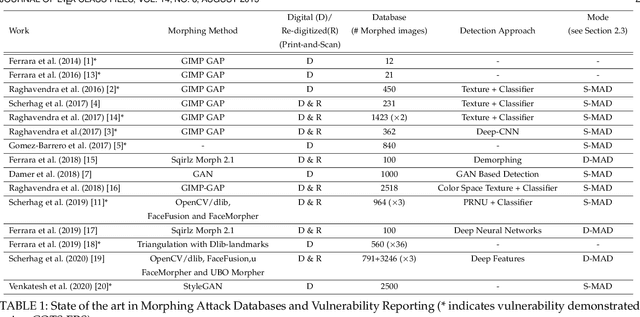
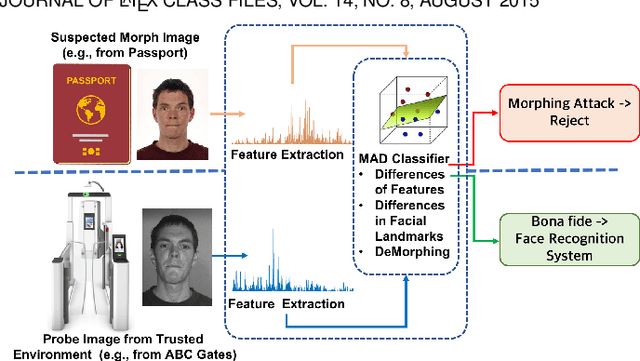

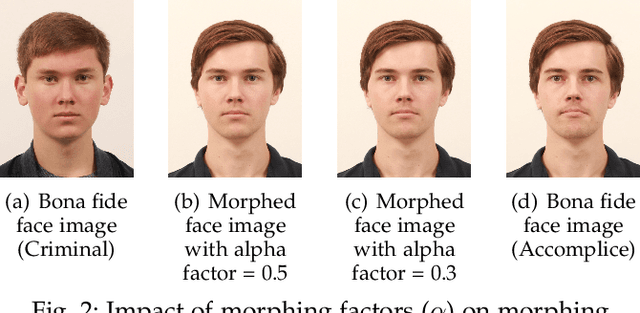
Abstract:Morphing attacks have posed a severe threat to Face Recognition System (FRS). Despite the number of advancements reported in recent works, we note serious open issues that are not addressed. Morphing Attack Detection (MAD) algorithms often are prone to generalization challenges as they are database dependent. The existing databases, mostly of semi-public nature, lack in diversity in terms of ethnicity, various morphing process and post-processing pipelines. Further, they do not reflect a realistic operational scenario for Automated Border Control (ABC) and do not provide a basis to test MAD on unseen data, in order to benchmark the robustness of algorithms. In this work, we present a new sequestered dataset for facilitating the advancements of MAD where the algorithms can be tested on unseen data in an effort to better generalize. The newly constructed dataset consists of facial images from 150 subjects from various ethnicities, age-groups and both genders. In order to challenge the existing MAD algorithms, the morphed images are with careful subject pre-selection created from the subjects, and further post-processed to remove the morphing artifacts. The images are also printed and scanned to remove all digital cues and to simulate a realistic challenge for MAD algorithms. Further, we present a new online evaluation platform to test algorithms on sequestered data. With the platform we can benchmark the morph detection performance and study the generalization ability. This work also presents a detailed analysis on various subsets of sequestered data and outlines open challenges for future directions in MAD research.
A Survey on Unknown Presentation Attack Detection for Fingerprint
May 17, 2020


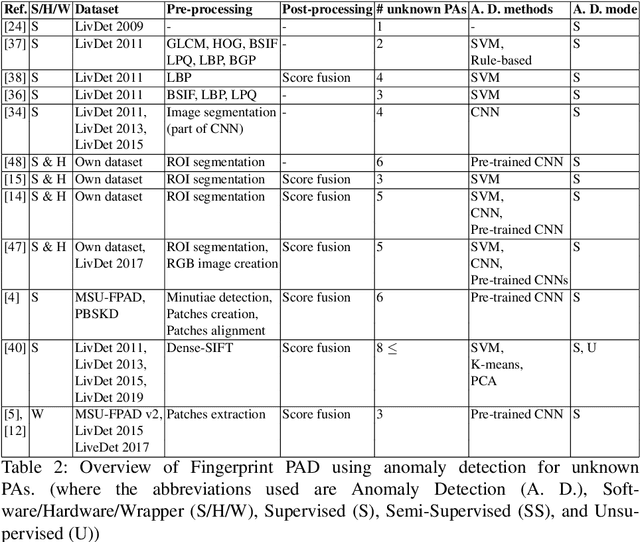
Abstract:Fingerprint recognition systems are widely deployed in various real-life applications as they have achieved high accuracy. The widely used applications include border control, automated teller machine (ATM), and attendance monitoring systems. However, these critical systems are prone to spoofing attacks (a.k.a presentation attacks (PA)). PA for fingerprint can be performed by presenting gummy fingers made from different materials such as silicone, gelatine, play-doh, ecoflex, 2D printed paper, 3D printed material, or latex. Biometrics Researchers have developed Presentation Attack Detection (PAD) methods as a countermeasure to PA. PAD is usually done by training a machine learning classifier for known attacks for a given dataset, and they achieve high accuracy in this task. However, generalizing to unknown attacks is an essential problem from applicability to real-world systems, mainly because attacks cannot be exhaustively listed in advance. In this survey paper, we present a comprehensive survey on existing PAD algorithms for fingerprint recognition systems, specifically from the standpoint of detecting unknown PAD. We categorize PAD algorithms, point out their advantages/disadvantages, and future directions for this area.
Detecting Finger-Vein Presentation Attacks Using 3D Shape & Diffuse Reflectance Decomposition
Dec 03, 2019
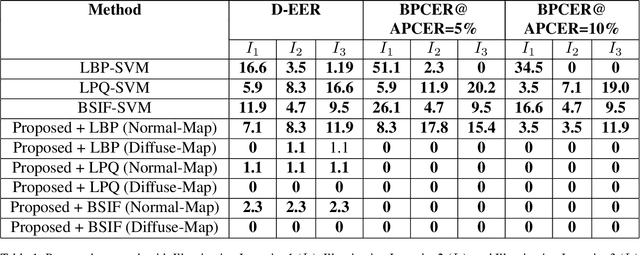
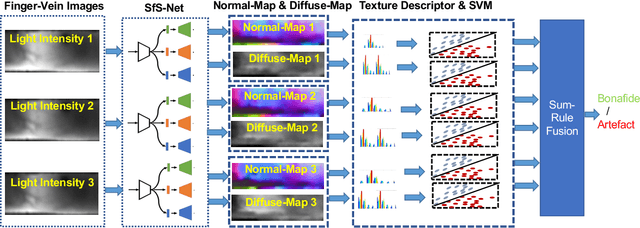

Abstract:Despite the high biometric performance, finger-vein recognition systems are vulnerable to presentation attacks (aka., spoofing attacks). In this paper, we present a new and robust approach for detecting presentation attacks on finger-vein biometric systems exploiting the 3D Shape (normal-map) and material properties (diffuse-map) of the finger. Observing the normal-map and diffuse-map exhibiting enhanced textural differences in comparison with the original finger-vein image, especially in the presence of varying illumination intensity, we propose to employ textural feature-descriptors on both of them independently. The features are subsequently used to compute a separating hyper-plane using Support Vector Machine (SVM) classifiers for the features computed from normal-maps and diffuse-maps independently. Given the scores from each classifier for normal-map and diffuse-map, we propose sum-rule based score level fusion to make detection of such presentation attack more robust. To this end, we construct a new database of finger-vein images acquired using a custom capture device with three inbuilt illuminations and validate the applicability of the proposed approach. The newly collected database consists of 936 images, which corresponds to 468 bona fide images and 468 artefact images. We establish the superiority of the proposed approach by benchmarking it with classical textural feature-descriptor applied directly on finger-vein images. The proposed approach outperforms the classical approaches by providing the Attack Presentation Classification Error Rate (APCER) & Bona fide Presentation Classification Error Rate (BPCER) of 0% compared to comparable traditional methods.
Robust Morph-Detection at Automated Border Control Gate using Deep Decomposed 3D Shape and Diffuse Reflectance
Dec 03, 2019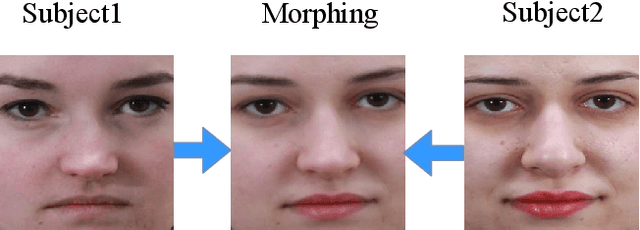


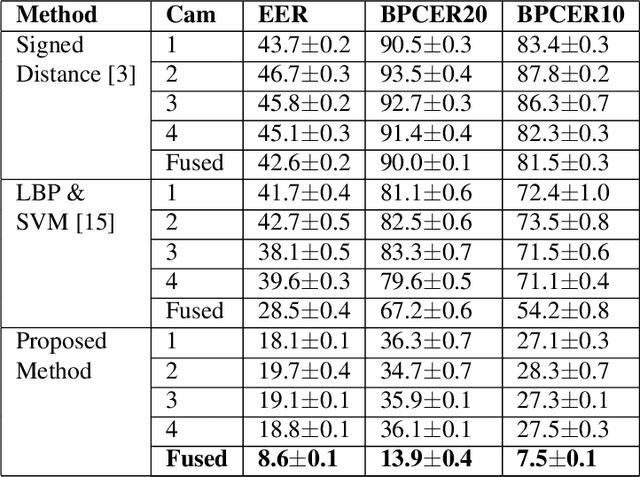
Abstract:Face recognition is widely employed in Automated Border Control (ABC) gates, which verify the face image on passport or electronic Machine Readable Travel Document (eMTRD) against the captured image to confirm the identity of the passport holder. In this paper, we present a robust morph detection algorithm that is based on differential morph detection. The proposed method decomposes the bona fide image captured from the ABC gate and the digital face image extracted from the eMRTD into the diffuse reconstructed image and a quantized normal map. The extracted features are further used to learn a linear classifier (SVM) to detect a morphing attack based on the assessment of differences between the bona fide image from the ABC gate and the digital face image extracted from the passport. Owing to the availability of multiple cameras within an ABC gate, we extend the proposed method to fuse the classification scores to generate the final decision on morph-attack-detection. To validate our proposed algorithm, we create a morph attack database with overall 588 images, where bona fide are captured in an indoor lighting environment with a Canon DSLR Camera with one sample per subject and correspondingly images from ABC gates. We benchmark our proposed method with the existing state-of-the-art and can state that the new approach significantly outperforms previous approaches in the ABC gate scenario.
 Add to Chrome
Add to Chrome Add to Firefox
Add to Firefox Add to Edge
Add to Edge